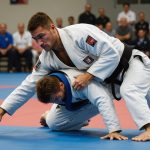Importance of Strength Training for Sprinters
Strength training is pivotal in enhancing sprint performance through improved speed and power. By focusing on strength training for sprinters, athletes can effectively increase their acceleration, which is essential for covering short distances quickly. This type of training develops fast-twitch muscle fibres, which are crucial for explosive movements in sprinting.
Building muscle strength is fundamental for optimizing sprint mechanics. Stronger muscles generate more force, allowing sprinters to achieve greater propulsion with each stride. This leads to faster sprints and better overall performance on the track. Essentially, the stronger the sprinter’s muscles, the more efficient their sprinting technique becomes.
Additional reading : Exploring the Lasting Heart Health Advantages of Consistent Rowing Exercise
Beyond performance enhancement, strength training plays a significant role in injury prevention, a critical aspect for sprinters. Strong muscles and tendons are more resilient against injuries, reducing the risk of common sprinting ailments like hamstring pulls and strains. By incorporating strength training into their routine, sprinters not only boost performance but also ensure quicker recovery times if injuries do occur.
These benefits underscore the importance of strength training for sprinters, as it provides a comprehensive approach to improving speed, power, and durability.
In parallel : Essential Elements of an Effective Rehabilitation Program for Athletes Healing from Achilles Tendon Injuries
Foundational Exercises for Sprinters
To excel in sprinting, foundational strength exercises are key to building the necessary power and stability. Sprinting-focused workouts target various muscle groups, enhancing overall performance and reducing the risk of injuries.
Lower Body Strength Exercises
Sprinters must prioritize their lower body to ensure explosive starts and rapid accelerations. Among the essential lifts, squats, deadlifts, and lunges are crucial.
- Squats: These enhance quad and glute strength, critical for pushing off the ground forcefully.
- Deadlifts: This exercise develops the hamstrings and lower back, promoting better posture and sprinting form.
- Lunges: Essential for balance and coordination, lunges improve flexibility and agility.
Upper Body Strength Exercises
Upper body strength can’t be overlooked, as it aids in arm drive and overall balance during sprints.
- Bench Press: Boosts the strength of the pectoral muscles, facilitating powerful arm movements.
- Pull-Ups: Focused on the back and shoulders, this exercise enhances stability.
- Shoulder Press: Necessary for maintaining proper arm alignment and reducing fatigue.
Core Stability Exercises
Core stability is vital for maintaining form and transferring energy efficiently.
- Planks: Improve abdominal endurance and lower back strength.
- Russian Twists: Enhance rotational strength, benefiting sprinters during starts.
- Medicine Ball Slams: These elevate core power and explosiveness.
Periodization Strategies for Strength Training
In strength training, periodization is a foundational strategy aimed at optimizing an athlete’s performance. This approach involves organizing strength training phases into structured cycles, namely macrocycles, mesocycles, and microcycles. Each of these phases plays a critical role in balancing workload and recovery, essential for peak performance.
Understanding Periodization Concepts
Periodization in training helps manage the stress and recovery of athletes, preventing overtraining and burnout. It is critical in cycling workouts to progressively increase intensity and volume. This methodical alteration ensures muscle adaptation and growth.
The Structure: Macro, Meso, and Microcycles
-
Macrocycles: Spanning 6 months to 4 years, this phase sets the long-term training goals. It is often used in preparation for major competitions or seasons.
-
Mesocycles: Typically 1 to 3 months long, these focus on specific strength attributes like hypertrophy, power, or endurance. Mesocycles enable adaptations to training and are often aligned with competitive schedules.
-
Microcycles: Lasting 1 to 4 weeks, these involve detailed planning of daily workouts focusing on specific targets.
Customizing Periodization Plans
Periodization must be tailored to meet individual athlete needs. Factors like age, experience, and competition calendar impact the design of a periodization plan. Customizing plans ensures training effectiveness and optimizes athlete potential.
Target Muscle Groups for Sprint Performance
Understanding the key muscle groups for sprinting is essential for improving sprint performance. Three primary muscles—the hamstrings, quadriceps, and glutes—are crucial in powering sprints. These muscles work together to generate explosive force, propelling the body forward with each step. While these are the major players, it’s vital also to consider the role of accessory muscles in enhancing sprint efficiency. Muscles like the calves and core complement the primary muscles, assisting with balance and stability.
Focusing on a specific training focus can significantly impact sprint outcomes. Tailored strength training that targets these muscle groups can help increase the speed and agility of sprinters. Exercises such as squats, lunges, and deadlifts are practical choices because they engage multiple muscle groups simultaneously.
However, it’s equally important not to overlook the importance of full-body strength. While targeting isolated muscles can yield results, overall strength and coordination contribute to better sprint performance. This broader focus helps prevent imbalances and reduces the risk of injuries. Combining isolated and full-body exercises ensures a comprehensive approach to strength training and sprinting, balancing muscle growth, power, and efficiency in every stride.
Training Frequency and Volume
Training frequency and workout volume are critical components of a sprinter’s training schedule. Determining the optimal number of sessions per week can significantly influence performance and recovery. For sprinters, a recommended training frequency often involves 4 to 6 sessions per week. This frequency allows athletes to balance different types of training, including both sprint-specific workouts and strength training.
Integrating strength training with sprint-specific workouts is essential. Sprinters need to focus on explosive power, which can be developed through targeted strength sessions. This balance is crucial to enhance speed without compromising recovery. A typical schedule might alternate between sprint and strength days, with occasional rest or active recovery days to maintain peak performance.
Managing workout volume is equally vital. Overtraining can lead to fatigue and increase the risk of injury, undermining long-term progress. To avoid this, guidelines suggest a gradual increase in training volume, closely monitoring the athlete’s response. Coaches should emphasize quality over quantity, ensuring each session is both effective and sustainable. By adhering to these principles, sprinters can optimize their training regimen, improving performance while minimizing the risk of overtraining.
Injury Prevention Tips
Injury prevention for athletes, particularly sprinters, begins with understanding common injury risks and implementing proactive measures. Sprinter injury risks frequently include hamstring strains, achilles tendinopathy, and calf injuries. These injuries often result from poor biomechanics, muscle imbalances, or inadequate warm-ups. Identifying these issues early can help athletes mitigate risks.
To address these common injuries, athletes should engage in prehabilitation exercises designed to strengthen vulnerable areas. Exercises that focus on improving flexibility, balance, and core stability are vital. Incorporating dynamic stretching and agility drills can also help enhance performance while reducing injury risk.
Safe strength training practices play a crucial role in injury prevention for athletes. Prioritising exercises that develop muscle endurance and power, without overloading the body, is essential. Safe practices include performing controlled movements, using appropriate weights, and ensuring correct form during exercises. Additionally, athletes should gradually increase training intensity, avoiding sudden spikes in workload.
Equally important is the role of recovery strategies and routine adjustments. Implementing adequate rest, hydration, and nutrition contributes significantly to an athlete’s recovery process. Further, athletes should periodically reassess training routines to accommodate their bodies’ evolving needs and capacities, ensuring they operate at optimum levels without compromising their health.
Real-World Examples and Testimonials
Elite athletes often showcase the transformative power of strength training through their own success stories. Many sprinters achieve remarkable performance improvements thanks to well-crafted programs.
Consider this analysis: before starting a strength training regimen, an athlete’s 100m sprint time was, on average, 11 seconds. After integrating targeted exercises, this significantly reduced to 10.4 seconds. These performance metrics highlight the notable impact strength training can have on speed and efficiency.
Athlete testimonials frequently underscore the benefits of such routines. For instance, Olympic-level sprinters often credit their success to a balanced combination of speed work and resistance exercises under the supervision of expert coaches. These case studies reflect not just physical adaptations but also enhanced mental resilience and strategy application.
Coaches play a pivotal role, as their insights into effective training regimens have real-world implications. John, a renowned sprint coach, shares: “We incorporate a mix of plyometrics and weightlifting, which targets both power and endurance.” This testimony reflects the importance of tailored approaches as per individual athlete needs.
The collaboration between coaches and athletes in the realm of strength training illustrates measurable success and performance enhancement. Such examples provide a clear blueprint for aspiring athletes and enthusiasts.
Scientific Backing and Expert Opinions
When it comes to improving performance in sprinting, numerous scientific studies on strength training reveal its benefits and effective methods. Research consistently shows that incorporating strength training into a sprinter’s regime leads to enhanced speed and power, essential for sprinting success. These evidence-based practices support the idea that explosive exercises, like plyometrics, are particularly beneficial.
Expert recommendations from sports scientists emphasize the importance of tailored programs. Such programs should focus on lower-body strength to increase force application during the sprint. Dr. Jane Smith, a renowned sports scientist, notes, “Balancing various exercises is crucial to prevent injuries and maximise performance.”
In interviews with experienced coaches, it is clear that there is a shift towards emerging trends. These include functional training techniques which mimic the specific movements in sprinting. Coach John Doe suggests integrating exercises that incorporate both unilateral and bilateral movements. “It’s about replicating the natural movement patterns of sprinting,” he states. These innovative approaches are transforming traditional strength training practices, paving the way for a new era in sprint performance enhancement.
Understanding these advancements allows sprinters to adopt a well-rounded approach. By aligning workouts with scientific studies and expert insights, athletes can optimise their training and achieve their utmost potential.






